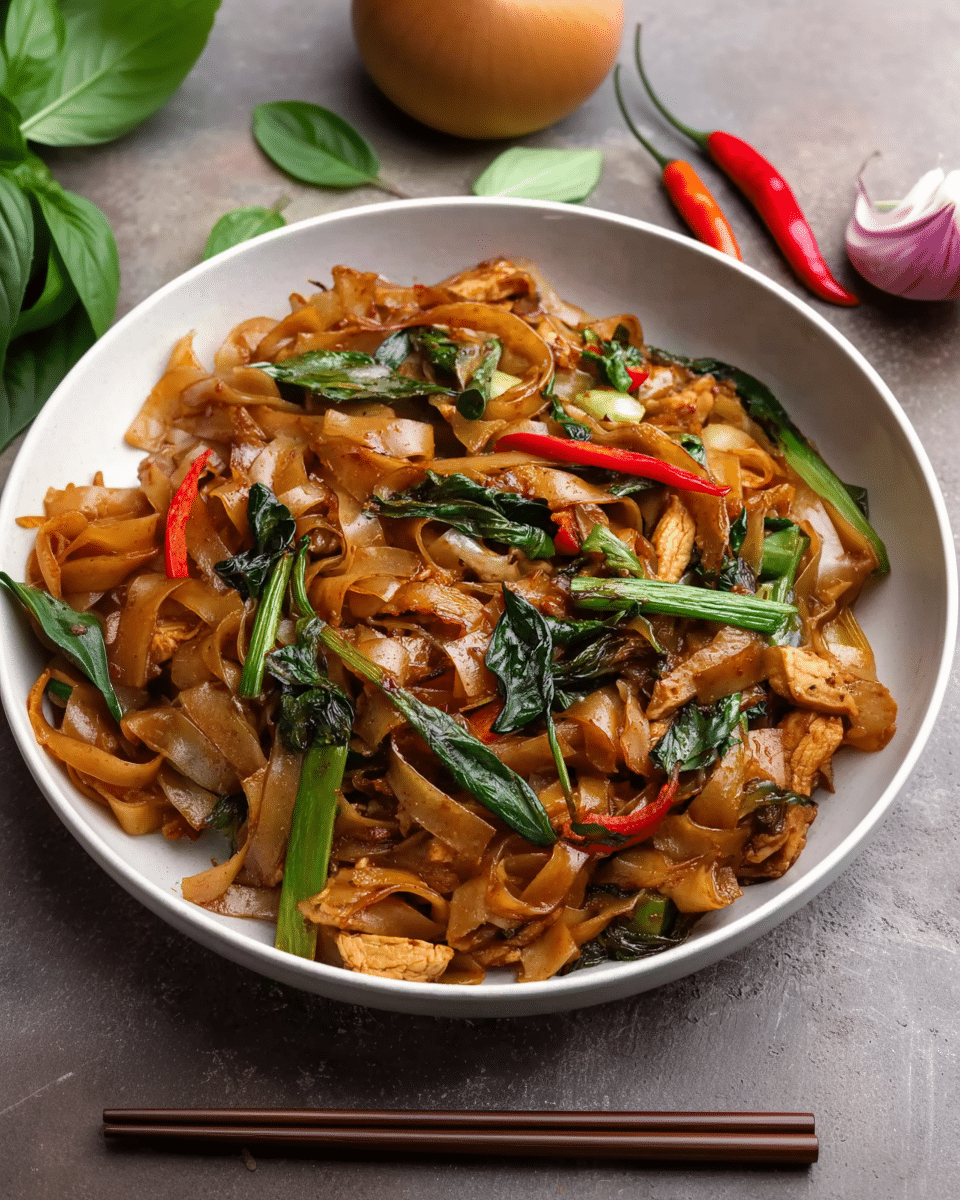Drunken Noodles (Pad Kee Mao) is a flavorful Thai street food dish known for its spicy, savory, and slightly smoky flavors. Despite the name, there’s no alcohol in this dish. The noodles are stir-fried with tender chicken, aromatic garlic, fresh vegetables, and Thai basil, all coated in a savory sauce that delivers a perfect balance of sweet, salty, and spicy notes. This easy and quick recipe is ideal for a weeknight dinner or when you crave bold, comforting flavors.
Full Recipe:
Ingredients
-
For the Noodles:
-
250g medium wide rice noodles (dried)
-
250g boneless chicken (breast or thighs), cut into thin strips
-
1 tsp soy sauce
-
2-3 tbsp vegetable oil
-
1 tbsp minced garlic
-
½ onion, sliced
-
2-3 Thai red chili peppers
-
4-5 baby bok choy (or other veggies like Chinese broccoli, mushrooms)
-
1 cup holy basil (or Thai basil)
-
1-2 green onions, sliced
-
-
For the Stir Fry Sauce:
-
3 tsp soy sauce
-
1 ½ tsp dark soy sauce
-
2 tsp oyster sauce
-
1 tbsp + 1 tsp fish sauce
-
2 tsp brown sugar
-
Pinch of ground white pepper
-
¼ cup chicken stock or water
-
Directions
-
Prep the Chicken and Noodles: Marinate the chicken strips with 1 tsp soy sauce for about 15-20 minutes. Soak the rice noodles in hot water for 15-20 minutes, then drain and set aside.
-
Prepare the Stir Fry Sauce: Mix all the ingredients for the stir fry sauce in a bowl.
-
Sear the Chicken: Heat 2 tbsp of oil in a wok or large skillet over high heat. Add the marinated chicken and sear for about 2 minutes until it’s nearly cooked through. Remove from the pan and set aside.
-
Cook the Aromatics and Veggies: In the same wok, add the remaining oil and sauté the sliced onion, green onion, garlic, and red chili peppers over high heat for 1 minute until fragrant. Add the bok choy (or other veggies) and stir-fry for about 30 seconds.
-
Combine Noodles and Chicken: Add the cooked noodles and chicken back into the wok along with the stir fry sauce. Toss everything together for 2 minutes until the noodles are coated with the sauce and slightly charred.
-
Add the Basil and Serve: Stir in the fresh basil leaves and cook for another 30 seconds. Serve the drunken noodles hot, garnished with more green onions.
Nutrients (per serving)
-
Calories: 228 kcal
-
Carbohydrates: 52g
-
Protein: 2g
-
Fat: 0.3g
-
Sodium: 114mg
-
Fiber: 1g
-
Sugar: 3g
-
Iron: 0.4mg
The Key Ingredients That Make Drunken Noodles Special
What sets Drunken Noodles apart from other stir-fried noodle dishes is its rich blend of ingredients that deliver distinctive flavors. The wide rice noodles serve as a comforting and chewy base, while the chicken strips, whether from the breast or thighs, add tenderness and protein. The sauce, a mixture of soy sauce, oyster sauce, fish sauce, and brown sugar, brings the perfect balance of savory, sweet, and umami flavors. The heat from the Thai red chili peppers and the aromatic garlic and onion create a bold foundation for the dish. And, of course, the fresh Thai basil adds a unique herbal fragrance that elevates the entire meal, contributing a fresh and slightly peppery note.
Choosing the Right Noodles
The noodles in Drunken Noodles play a crucial role in the dish’s texture and enjoyment. Medium-wide rice noodles, also known as “sen yai,” are traditional for this dish. They are flat and wide, which helps them absorb the flavorful sauce and retain a chewy, satisfying texture when stir-fried. These noodles are available in both dried and fresh forms, but using dried rice noodles is the most common option. To prepare them, simply soak the dried noodles in hot water for 15-20 minutes to rehydrate before stir-frying. This step ensures the noodles are soft and ready to absorb the sauce, while still retaining their signature chewiness.
Preparing the Stir Fry Sauce
The stir-fry sauce for Drunken Noodles is where much of the flavor magic happens. The combination of soy sauce, dark soy sauce, oyster sauce, fish sauce, and brown sugar creates a deeply savory, slightly sweet, and umami-packed sauce that ties the dish together. The soy sauce adds saltiness, while the dark soy sauce deepens the color and flavor with its rich, molasses-like undertones. The oyster sauce contributes a subtle seafood umami, and the fish sauce adds that signature Thai pungency. A pinch of white pepper adds an extra layer of heat, complementing the fresh chilis and giving the dish its bold, spicy kick. Chicken stock or water is added to balance the consistency and help the sauce coat the noodles.
Cooking the Chicken and Vegetables
To achieve the perfect stir-fry, it’s important to cook each ingredient at the right time. Start by marinating the chicken with soy sauce to infuse it with flavor, then sear it in hot oil to develop a crispy exterior while keeping the inside juicy and tender. The chicken only needs about 2 minutes of searing in high heat to cook through, after which it is set aside. This allows the chicken to retain its moisture and flavor while the vegetables and aromatics are sautéed in the same wok.
In the same wok, you’ll cook the onions, garlic, and red chili peppers. The goal here is to sauté them quickly over high heat to release their aromatic oils, creating a fragrant base for the noodles. Adding vegetables like baby bok choy (or other greens like Chinese broccoli) next ensures they remain crisp-tender, adding both texture and freshness to the dish. The short stir-fry time helps preserve their vibrant color and nutrients while still allowing them to soften slightly in the hot wok.
Bringing It All Together: Noodles, Sauce, and Chicken
Once the aromatics and vegetables are sautéed, it’s time to bring everything together. The rehydrated rice noodles and seared chicken are added to the wok, followed by the stir-fry sauce. Toss everything together, allowing the noodles to absorb the sauce, which will help them develop a slightly charred, smoky flavor. Stir-frying for 2 minutes ensures the noodles get coated with the flavorful sauce while retaining their chewy texture. It’s this slight char and the sauce’s caramelization that gives Drunken Noodles its signature depth of flavor.
Finishing Touches with Thai Basil and Green Onions
The final touch to Drunken Noodles is the addition of fresh Thai basil. Stir in the basil leaves just before serving, allowing them to wilt slightly in the heat of the noodles while releasing their distinct fragrance. The fresh basil adds a peppery, herbal note that balances the richness of the sauce and the heat from the chilies. Garnishing the dish with additional green onions provides a crunchy, fresh contrast to the savory flavors and gives the dish a burst of color.
Serving Drunken Noodles
Drunken Noodles is best enjoyed hot, straight from the wok, and it’s the perfect one-pan meal to serve for dinner. Whether you serve it as a quick weeknight meal or as part of a larger Thai-inspired dinner spread, this dish is sure to impress with its bold flavors and satisfying textures. If you’re serving it for guests, you can plate the noodles in individual bowls or family-style on a large platter, garnished with more green onions and a sprinkle of fresh basil.
Customization and Variations
One of the best things about Drunken Noodles is how easy it is to customize based on your preferences or what you have available. While chicken is commonly used in this dish, you can easily swap it out for other proteins such as shrimp, beef, or tofu for a vegetarian version. Feel free to experiment with different vegetables based on what’s in season or what you enjoy—mushrooms, bell peppers, and carrots would all be great additions.
If you prefer a less spicy version, you can reduce the number of Thai red chilies or even omit them entirely. For an extra punch of flavor, add a squeeze of lime juice just before serving, which adds a fresh, tangy note that balances the richness of the sauce.
Nutritional Information
Drunken Noodles offers a balanced meal with a good amount of carbohydrates from the rice noodles and a healthy dose of vegetables. The dish is also relatively low in fat, with just 0.3g per serving, making it a lighter option compared to other stir-fried noodle dishes. With 2g of protein per serving, it’s not a significant source of protein on its own, but adding a protein source like chicken, shrimp, or tofu will increase the nutritional value. The sodium content is moderate due to the fish sauce and soy sauce, so be mindful if you’re watching your salt intake.
Conclusion
Drunken Noodles (Pad Kee Mao) is a flavorful and satisfying dish that combines spicy, savory, and slightly smoky flavors in every bite. With its rich, umami-packed sauce, chewy rice noodles, tender chicken, and fresh vegetables, it’s the perfect meal to enjoy when you want something bold and comforting. The versatility of the dish allows for easy customization based on your dietary preferences, making it suitable for a wide range of tastes. Whether you’re a fan of Thai cuisine or just looking to try something new, Drunken Noodles is sure to become a favorite in your cooking repertoire.

